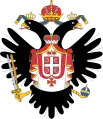Voivodeship of Serbia and Banat of Temeschwar
The Voivodeship of Serbia and Banat of Temeschwar or Serbian Voivodeship and the Banate of Temes (German: Woiwodschaft Serbien und Temeser Banat, Serbian: Војводство Србија и Тамишки Банат, Romanian: Voivodina sârbească și Banatul timișan, Hungarian: Szerb Vajdaság és Temesi Bánság), known simply as the Serbian Voivodeship (Serbische Woiwodschaft), was a crownland of the Austrian Empire that existed between 1849 and 1860.
| Voivodeship of Serbia and Temes Banate | |||||||||||
|---|---|---|---|---|---|---|---|---|---|---|---|
| Crownland of the Austrian Empire | |||||||||||
| 1849–1860 | |||||||||||
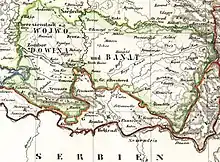 | |||||||||||
| Capital | Temeschwar | ||||||||||
| History | |||||||||||
| • Type | Voivodeship | ||||||||||
| History | |||||||||||
• Established | 18 November 1849 | ||||||||||
• Disestablished | 27 December 1860 | ||||||||||
| |||||||||||
| Today part of | Serbia Partial in: Romania Hungary Croatia | ||||||||||
.png.webp)
It was a separate crownland named after two former provinces: Serbian Vojvodina and Banat of Temeswar. Its former area is now divided between Serbia, Romania and Hungary. The Voivodeship gave its name to the present Serbian Vojvodina.
Names
In contemporary German, the crown land was officially known as Woiwodschaft Serbien und Temeser Banat[1] ('Voivodeship of Serbia and Temes Banat'; die Woiwodschaft Serbien und das Temeser Banat when definite). The forms die serbische Wojwodschaft und das Temeser Banat[2] ('the Serbian Voivodeship and the Temes Banat') and die serbische Wojwodschaft mit dem Temeser Banate[3] ('the Serbian Voivodeship with the Temes Banat'; the -e on Banat is a now mostly obsolete dative ending) also appeared frequently in official documents. Other variations also appear as a result of grammatical inflection (see German grammar), such as der serbischen Wojwodschaft und des Temeser Banates[3] (genitive case), but these should not be considered distinct. The spellings Woiwodschaft and Wojwodschaft are typographic variations; Woiwodschaft was used officially until 1852, Wojwodschaft from 1853.
In contemporary Serbian it was known as Vojvodina Srbska i Tamiški Banat (Войводина Србска и Тамишки Банат)[4] and Vojvodstvo Srbija i Tamiški Banat (Војводство Србија и Тамишки Банат).[5] In Hungarian it was known as Szerb Vajdaság és Temesi Bánság, and in Romanian as Voivodina Sârbească și Banatul Timișan.
As in German, in Serbian sources there are two somewhat different variants of the name of the voivodeship; one could be translated into English as Voivodeship of Serbia and Temes Banat and another as Serbian Voivodeship and Temes Banat.
Also in modern English use, the term Temes Banat or Banat of Temes is sometimes incorrectly replaced with term Banat of Temeschwar or Temeschwar Banat. In the original name in all native languages, there is no mention of the city of Temeschwar (Timișoara) in the title of Voivodeship. As shown above, the reference to the Temes region is always used, and should be translated into English as Temes Banat or Banat of Temes.
History
The Voivodeship was formed by a decision of the Austrian emperor in November 1849, after the Revolutions of 1848/1849. It was formed in accordance with privilege given to Serbs by the Habsburg emperor in 1691, recognizing the right of Serbs to territorial autonomy within the Habsburg monarchy.
It consisted of the regions of Banat, Bačka and northern Syrmian municipalities of Ilok and Ruma. An Austrian governor seated in Temeschwar ruled the area, and the title of Voivode belonged to the emperor himself. The full title of the emperor was "Grand Voivod of the Voivodeship of Serbia" (German: Großwoiwode der Woiwodschaft Serbien). Even after the Voivodeship was abolished, the emperor kept this title until the end of Austro-Hungarian Monarchy in 1918.
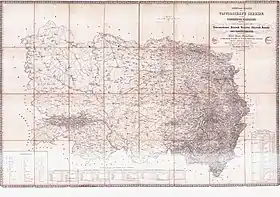
In 1860, the Voivodeship of Serbia and Temes Banat was abolished and most of its territory (Banat and Bačka) was incorporated into the Habsburg Kingdom of Hungary, although direct Hungarian rule began only in 1867, after the Austro-Hungarian Compromise. Unlike Banat and Bačka, in 1860 Syrmia was incorporated into the Kingdom of Slavonia, another separate Habsburg crown land. The Kingdom of Slavonia subsequently merged with the Kingdom of Croatia, forming the new kingdom of Croatia-Slavonia, which concluded an agreement with the Kingdom of Hungary in 1868, becoming an autonomous region of the Kingdom of Hungary within Austria-Hungary.
Languages
The two official languages of the Voivodeship were German and "Illyrian" (what would come to be known as Serbian).
Demographics
| History of Vojvodina |
|---|
|
|
The Voivodeship was ethnically very mixed, since the southern parts of Syrmia, Banat and Bačka with compact Serbian settlements were not included in it, while eastern Banat, with a Romanian majority was added to it.
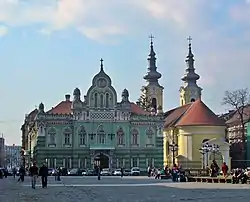
1846
According to the 1846 census, the territory that in 1849 formed the voivodeship included:[6]
1857
In 1857, population of the voivodeship numbered 1,526,105 inhabitants, including:[6]
- Roman Catholics = 698,189 (45.75%)
- Eastern Orthodox Christians = 691,828 (45.33%)
- Evangelic-Lutherans = 56,871 (3.73%)
- Evangelic-Reformists = 29,281 (1.92%)
- Greek Catholics and Armenian Catholics = 26,244 (1.72%)
- Jews = 23,203 (1.52%)
- others = 489 (0.03%)
1850/51
According to the 1850/51 census, ethnic composition of the voivodeship was as follows:[7]
- Romanians = 347,459
- Germans = 335,080
- Serbs = 321,110 (*)
- Hungarians = 221,845
- Bunjevci and Šokci = 62,936 (*)
- Rusins = 39,914
- Slovaks = 25,607
- Bulgarians = 22,780
- Jews = 15,507
- Gypsies = 11,440
- Czechs = 7,530
- Croats = 2,860 (*)
- Greeks and Cincars = 2,820
(*) Total number of "Illyrian Slavs" (Serbs, Bunjevci, Šokci, and Croats) was 386,906.
According to another source, in 1850/1851, the population of the voivodeship numbered 1,426,221 inhabitants, including:[6][8]
- 397,459 (27.87%) Romanians
- 335,080 (23.49%) Germans
- 321,110 (22.52%) Serbs
- 221,845 (15.56%) Hungarians
- others.
By religious makeup:
In 1851, population of the voivodeship numbered 1,426,221 inhabitants, including:
- Eastern Orthodox Christians = 694,029 (48.66%)
- Roman Catholics = 624,839 (43.81%)
- Evangelic-Lutherans = 51,724 (3.63%)
- Evangelic-Reformists = 26,621 (1.87%)
- Jews = 16,252 (1.14%)
- Greek Catholics and Armenian Catholics = 12,756 (0.89%)
1860
In 1860, population of the voivodeship numbered 1,525,523 inhabitants, including:[9]
- 432,523 Serbs
- 414,490 Romanians
- 396,156 Germans
- 256,164 Hungarians
Administrative divisions
At first, the crown land was divided into two districts:
- Batschka-Torontal (Bačka-Torontal)
- Temeschwar-Karasch (Timișoara-Caraș)
Later, it was divided into five districts[10][11] (contemporary German: Districte, modern spelling Distrikte), which were largely based on the pre-1849 Hungarian counties which made the majority of the crown land.[11] From 1851 they were subdivided into political districts ((politische) Bezirke).[11] In the reforms of 1853, implemented in the crown land in 1854, the Districte became Kreise, which were subdivided into Amtsbezirke (formally Bezirke but of a different type than in 1851).[3] These reforms also separated the capital, the city of Temesvár, from district-administration, placing it under the direct authority of the Statthalterei.[3]
| Official name | Other native names (district capital) | extent[11] | Bezirke | population (1850) | ||
|---|---|---|---|---|---|---|
| 1851[11] | 1854[3] | 1851 (political districts)[11] | 1854 (office districts)[3] | |||
| Temesvárer District | Kreis Temesvár |
|
pre-1849 Temes County |
|
316,565, including:
| |
| Lugoser District | Kreis Lugos |
|
pre-1849 Krassó County |
|
229,363, including:
| |
| Groß-Becskereker District | Kreis Gross-Becskerek |
|
pre-1849 Torontál County |
|
|
388,704, including:
|
| Zombórer District | Kreis Zombor |
|
the northern part of the pre-1849 Bács-Bodrog County |
|
376,366, including:
| |
| Neusatzer District | Kreis Neusatz |
|
the southern part of the pre-1849 Bács-Bodrog County and the formerly Syrmian districts of Ruma and Illok |
|
236,943, including:
| |
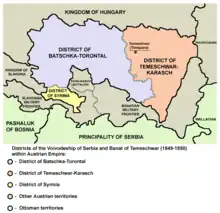 Districts of the Voivodeship of Serbia and Temes Banat (1849-1850).
Districts of the Voivodeship of Serbia and Temes Banat (1849-1850).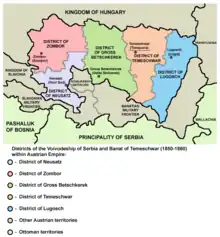 Districts of the Voivodeship of Serbia and Temes Banat (1850-1860).
Districts of the Voivodeship of Serbia and Temes Banat (1850-1860).
Administration

Great Voivodes
- Francis Joseph I, (1849–1916)
- Charles I, (1916–1918)
- Note: the voivodeship was abolished in 1860, but Francis Joseph kept the title of "Great Voivode" until his death in 1916, and the title was also inherited by the last Emperor of Austria, Charles I.[12]
Governors
- Ferdinand Mayerhofer, (1849–1851)
- Johann Coronini-Cronberg, (1851–1859)
- Josip Šokčević, (1859–1860)
- Karl Bigot de Saint-Quentin, (1860)
References
- Patent vom 18. November 1849, RGBl. 25/1849: "Kaiserliches Patent vom 18. November 1849, womit das, die Bacska und das Banat, den Rumáer und Illokér Bezirk umfassende Territorium vorläufig zu einem eigenen Verwaltungsgebiete unter der Benennung: "Woiwodschaft von Serbien und Temeser Banat" gebildet, dessen Untertheilung in Kreise und Bezirke angeordnet, und dem kaiserlichen Titel Sr. Majestät der eines "Großwoiwoden der Woiwodschaft von Serbien" beigefügt wird". Reichs-Gesetz-Blatt für das Kaiserthum Österreich (in German). 1849-11-18. Retrieved 2023-07-17 – via ÖNB-ALEX - Historische Rechts- und Gesetztexte Online.
- Patent vom 24. Juni 1857, RGBl. 121/1857: "Kaiserliches Patent vom 24. Juni 1857, wirksam für die Königreiche Ungarn, Kroatien und Slawonien, für das Großfürstenthum Siebenbürgen, für die serbische Wojwodschaft und das Temeser Banat, wodurch für diese Kronländer das Forstgesetz vom 3. December 1852 eingeführt, und vom 1. Jänner 1858 angefangen in Wirksamkeit gesetzt wird". Reichs-Gesetz-Blatt für das Kaiserthum Österreich (in German). 1857-06-24. Retrieved 2023-07-17 – via ÖNB-ALEX - Historische Rechts- und Gesetztexte Online.
- Gesetz 1. Februar 1854, RGBl. 28/1854: "Verordnung der Minister des Inneren, der Justiz und der Finanzen vom 1. Februar 1854, betreffend die politische und gerichtliche Organisirung der serbischen Wojwodschaft und des Temeser Banates". Reichs-Gesetz-Blatt für das Kaiserthum Österreich (in German). 1854-02-01. Retrieved 2023-07-17 – via ÖNB-ALEX - Historische Rechts- und Gesetztexte Online.
- Državna pisma o sojedinjenju Vojvodine Srbske i Tamiškog Banata sa Kraljevinom Ungarskom i dezvoljenom, u sljedatvu pomenutog sofedinjenja sa Vsevysoeajěim ruěnym pismom ed 21. febr - 5. marta 1861. izvanrednom Srbskom narodnim Soboru -: Staatsschriften über die Wiedervereinigung der Woiwodschaft Serbien und des Temescher Banates mit dem Konigreich Ungarn. Tip. Mitropolitske-Gimnazialna. 1861.
- Blagoveštenski Sabor Naroda Srbskog (SREMSKI KARLOVCI); Jovan ĐORĐEVIĆ (Founder of the Serbian National Theatre.) (1861). Радња Благовештенског Сабора Народа Србског у Сремским Карловцима 1861. Издао Јован. Ђорђевић.
- Lazo M. Kostić, Srpska Vojvodina i njene manjine, Novi Sad, 1999.
- Sima M. Ćirković, Srbi među evropskim narodima, Beograd, 2004.
- Dejan Mikavica, Srpska Vojvodina u Habsburškoj Monarhiji 1690-1920, Novi Sad, 2005.
- Milenko Palić, Srbi u Mađarskoj - Ugarskoj do 1918, Novi Sad, 1995, page 285.
- Drago Njegovan, Prisajedinjenje Vojvodine Srbiji, Novi Sad, 2004.
- Gesetz vom 17. August 1851, 192/1851: "Verordnung des Ministeriums des Innern, womit die durch Allerhöchste Entschließung sanctionirte Organisation der politischen Verwaltung der Woiwodschaft Serbien und des Temeser Banates kundgemacht wird". Reichs-Gesetz-Blatt für das Kaiserthum Österreich (in German). 1851-08-17. Retrieved 2023-07-17 – via ÖNB-ALEX - Historische Rechts- und Gesetztexte Online.
- thomasgraz.net
Sources
- Bataković, Dušan T., ed. (2005). Histoire du peuple serbe [History of the Serbian People] (in French). Lausanne: L’Age d’Homme. ISBN 9782825119587.
- Dušan J. Popović (1990). Srbi u Vojvodini. Matica srpska. ISBN 9788636301753.
- Lazo M. Kostić (1999). Srpska Vojvodina i njene manjine: demografsko-etnografska studija. Dobrica knjiga.
- Jovan Radonić (1956). Srpska Vojvodina od 1848-1851: (prikazano na VII skupu Odeljenja društvenih nauka 5 novembra 1955 g.).
- Dejan Mikavica (2005). Srpska Vojvodina u Habsburškoj Monarhiji 1690-1920. Novi Sad.
{{cite book}}: CS1 maint: location missing publisher (link) - Vasilije Krestić (2003). Iz prošlosti Srema, Bačke i Banata. Belgrade.
{{cite book}}: CS1 maint: location missing publisher (link) - Emanuel Salomon von Friedberg (1853). General-Karte der Vojvodschaft Serbien und des Temescher Banates : dann der vier Gränzregimenter Peterwardeiner Deutsch-Banater Illyrisch-Banater und Roman-Banater, endlich des Titler Gränz-Bataillons. na.
External links
- Bahovo doba - Vojvodstvo Srbija i Tamiški Banat (in Serbian)

